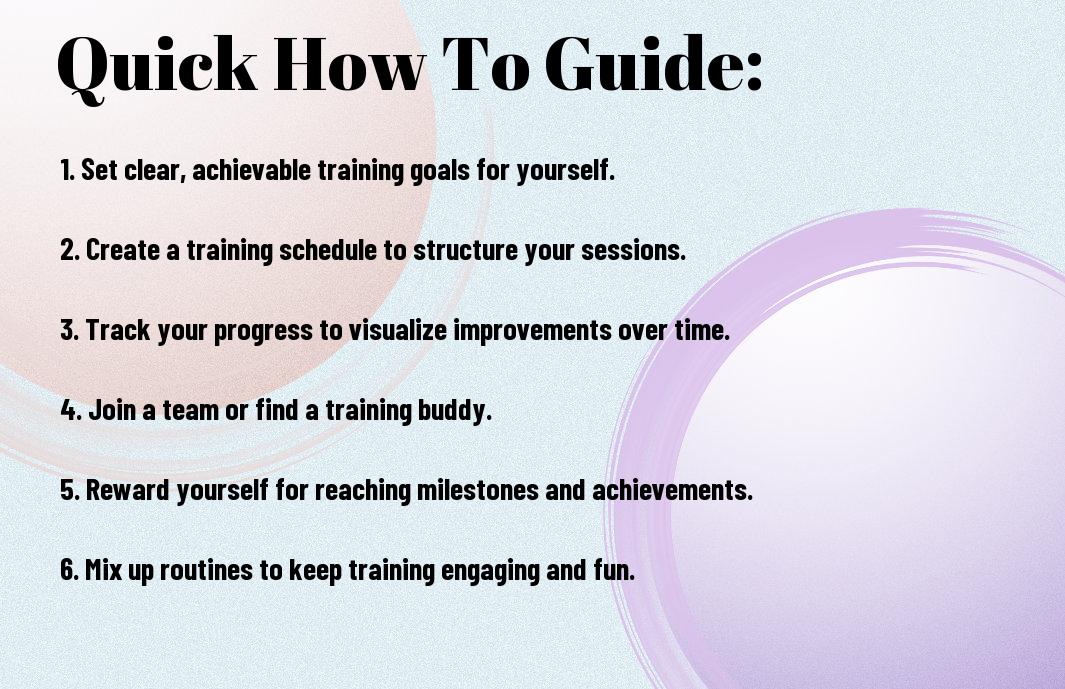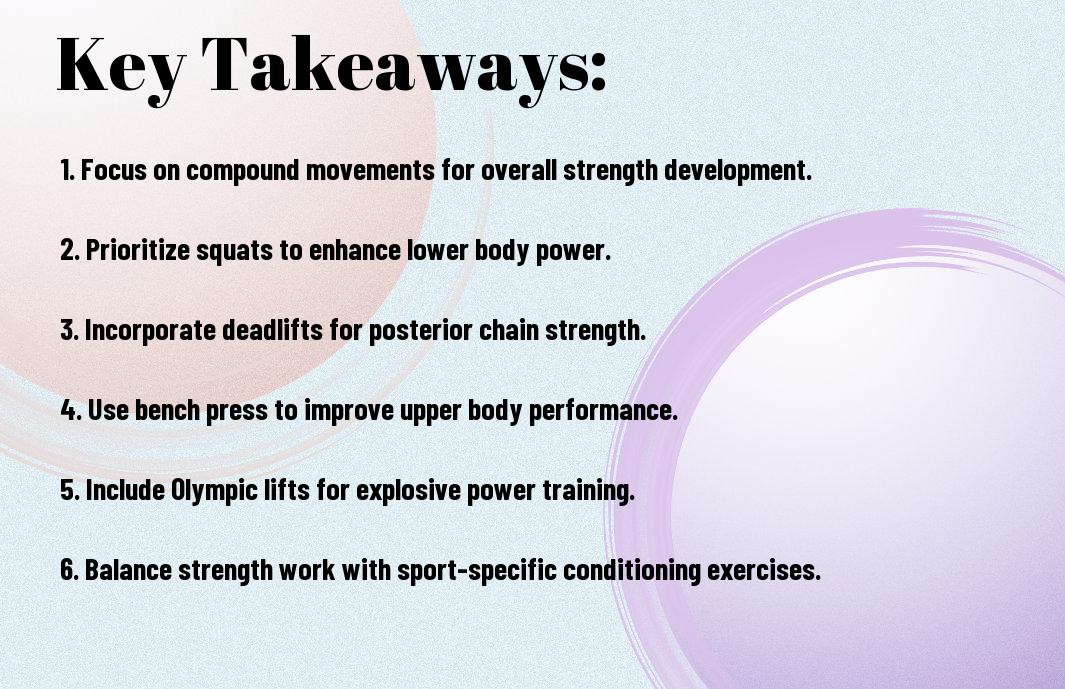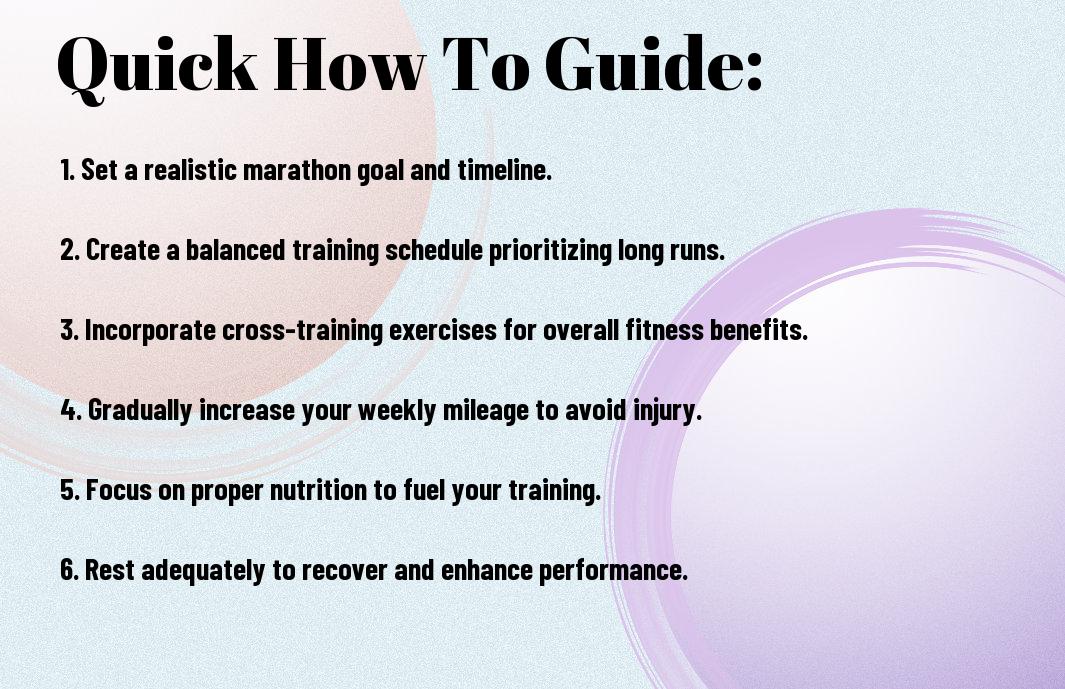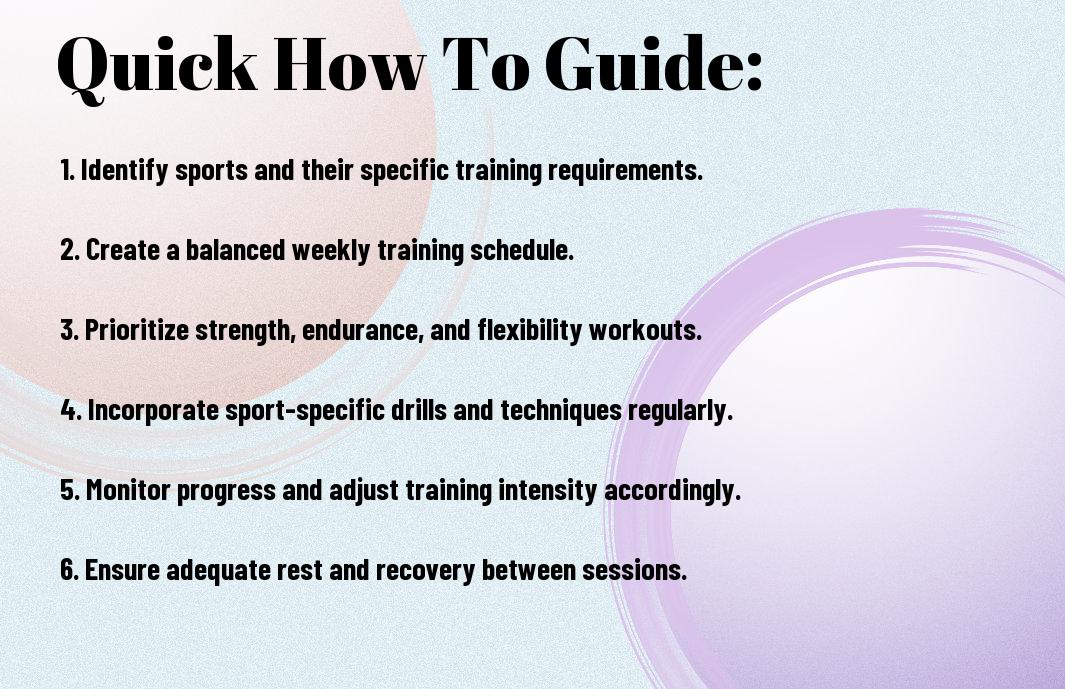Over time, maintaining motivation in your sports training can become a challenge, but it’s vital for achieving your goals. By identifying effective strategies and setting clear objectives, you can fuel your passion and commitment to your athletic pursuits. This guide will provide you with practical tips to boost your motivation, helping you stay focused and enthusiastic throughout your training journey. Whether you’re a seasoned athlete or just starting, these insights are designed to enhance your experience and performance in sports.
Key Takeaways:
- Set clear goals: Establish specific, measurable, and time-based objectives to guide your training.
- Create a routine: Develop a consistent training schedule to build discipline and make workouts a habit.
- Track progress: Regularly monitor and celebrate your improvements to stay engaged and motivated.
- Stay positive: Surround yourself with supportive people and maintain an optimistic mindset to enhance your training experience.
- Mix it up: Incorporate variety in your workouts to keep things interesting and prevent burnout.
Understanding Motivation
The key to successful sports training lies in understanding your motivation. It’s vital to recognize the reasons behind your passion for the sport, as this awareness can help propel you through your training sessions. For insights on how to enhance your dedication and drive, check out Stay Motivated in Training Sessions | Sports Psychology Tips.
The Psychology of Motivation
While motivation is a complex psychological construct, it fundamentally influences your behavior and performance in sports. Understanding what drives you can help you set specific goals and achieve greater consistency in your training. Reflecting upon your personal motivations will allow you to maintain focus and resilience, especially during challenging moments.
Intrinsic vs. Extrinsic Motivation
Some athletes are driven by intrinsic motivations, such as a genuine love for their sport, while others may be influenced by extrinsic rewards, like trophies or recognition. Balancing these motivations can enhance your training experience.
Motivation can be categorized as intrinsic, where you engage in activities for personal satisfaction, or extrinsic, where external factors like rewards or peer pressure play a significant role. Intrinsic motivation fosters a deeper connection with your training, ensuring sustained engagement, while extrinsic factors can offer short-term boosts. Understanding your motivations can help you train more effectively and improve your overall performance.

Setting Goals
While engaging in your sports training, establishing clear goals is important to maintain motivation and focus. Goals give you direction and purpose, enabling you to measure progress and celebrate achievements along the way. By defining both short and long-term objectives, you can create a roadmap that keeps you dedicated and passionate, ensuring that your training sessions are productive and fulfilling.
Short-term vs. Long-term Goals
Goals can be categorized into short-term and long-term objectives. Short-term goals are immediate achievements you aim for, such as improving your speed or perfecting a technique within weeks. Long-term goals represent your larger aspirations, like completing a marathon or achieving a personal best by the end of the season. Balancing both types of goals helps you stay motivated and provides a clear pathway to success.
SMART Goal Setting
Assuming you want to make your goals effective, implementing SMART criteria can enhance your goal-setting process. SMART stands for Specific, Measurable, Achievable, Relevant, and Time-bound. By formulating your objectives using these criteria, you ensure that they are well-defined and realistic, making it easier for you to stay focused and track your progress as you strive to achieve them.
It’s important to understand that SMART goals not only help in providing clarity but also boost your motivation by making the journey tangible. You can break down larger aspirations into smaller, actionable steps that feel more attainable. For instance, instead of simply saying, “I want to get faster,” you would specify, “I will improve my 5k time by 1 minute in the next 3 months,” which gives you a clear target to work towards. This structure fosters a sense of achievement as you reach each milestone, keeping your training engaging and purposeful.
Creating a Training Plan
Not having a structured training plan can lead to inconsistency and frustration in your sports training. A well-defined training plan not only sets clear goals but also allows you to track your progress effectively. Start by evaluating your current fitness level, establish short- and long-term goals, and schedule your training sessions to ensure you stay committed. Incorporate a mix of endurance, strength, and recovery workouts to keep things balanced and engaging.
Designing a Periodized Training Program
Even a simple periodized training program can help you avoid plateaus and injuries by incorporating variations in intensity and volume. Break your training into phases that gradually increase in difficulty, focusing on specific goals during each phase. For example, your program may include a base-building phase, followed by an intensity phase, and finally a peak phase before competition. This structured approach allows you to build fitness systematically, ensuring you perform your best when it matters most.
Adjusting Your Plan for Progress
Some adjustments to your training plan will be necessary as you monitor your progress and performance. Pay attention to how your body responds to different workouts, and don’t hesitate to make changes to keep pushing your limits. Whether it’s increasing the intensity, switching up exercises, or allowing for extra rest days, being flexible will help you maintain motivation and reduce the risk of burnout.
Plan to review your training plan regularly—ideally every few weeks—to assess your progress and make necessary adjustments. Check if you’re meeting your goals and how your body feels during training. If you’re consistently hitting your targets, consider increasing the difficulty or intensity of your workouts. Conversely, if you’re feeling fatigued or not progressing, it may be time to incorporate more recovery or modify your training loads. Listening to your body and being adaptable will enhance your performance and maintain your motivation.

Staying Accountable
Despite the challenges that come with maintaining motivation in your sports training, staying accountable can significantly enhance your commitment. Whether through personal goals or external commitments, having a system in place to track your progress keeps you engaged. Setting specific milestones and sharing them with others creates a sense of responsibility, ultimately propelling you forward.
Finding a Training Partner
Staying motivated can become much easier when you find a training partner who shares your goals. Working alongside someone who is equally dedicated brings a competitive edge and offers mutual encouragement. You’ll be more likely to push yourself and stick to your training schedule, making it a more enjoyable experience overall.
Utilizing Technology and Apps
Partnering with technology can also elevate your accountability in sports training. Numerous apps can help you track your workouts, monitor your progress, and set goals that keep you on track.
For instance, fitness apps like Strava or MyFitnessPal allow you to log workouts, track nutrition, and even connect with others in a community setting. This can provide positive reinforcement as you can see your improvements over time and get support from fellow users. Notifications and reminders can also help you stay disciplined, reminding you of your training commitments and encouraging you to stick with your plan.
Tips for Maintaining Motivation
Unlike many aspects of life, maintaining motivation in sports training requires consistent effort. Here are some strategies to keep your drive alive:
- Set specific and achievable goals.
- Track your progress regularly.
- Surround yourself with supportive individuals.
- Change up your routine frequently.
- Visualize your success regularly.
This combination of techniques can help you stay focused and engaged.
Rewarding Yourself
An effective way to keep your motivation high is by rewarding yourself for your achievements, no matter how small. Celebrating milestones reinforces positive behavior and makes the process enjoyable. Consider setting incentives for yourself, such as special treats, new gear, or relaxing activities, whenever you hit a training target. This keeps your mind invested in the journey ahead.
Keeping Variety in Training
Motivation can quickly wane if you get stuck in a repetitive routine. To prevent this, infuse your training schedule with variety, mixing up activities and workouts. This not only helps keep things fresh but also challenges your body in different ways, leading to overall improvement.
Plus, integrating a variety of training modalities, such as strength training, flexibility exercises, and cardio, can enhance your performance and prevent burnout. You might try cross-training, participate in different sports, or join group classes to diversify your regimen. Staying interested and engaged with your workouts will go a long way in helping you maintain your motivation and achieve your athletic goals.
Overcoming Psychological Barriers
To achieve your best in sports training, it’s crucial to confront and overcome psychological barriers that may hinder your performance. These mental obstacles can stem from fear of failure, self-doubt, or negative past experiences. By recognizing and addressing these challenges, you can cultivate a more positive mindset that propels you toward your goals.
Identifying Mental Blocks
To effectively address mental barriers, you must first identify them. Spend time reflecting on your thoughts and feelings during training sessions to pinpoint patterns that lead to a lack of motivation or focus. Journaling or discussing these feelings with a coach or mentor can help you gain clarity and better understand the sources of your mental blocks.
Techniques for Mental Resilience
Even when the going gets tough, developing mental resilience will help you push through challenges and maintain your motivation. You can employ techniques such as visualization, positive affirmations, and mindful breathing to fortify your mental strength and stay focused on your training goals.
Overcoming psychological barriers requires consistent practice of techniques that enhance mental resilience. Incorporate visualization exercises to picture yourself succeeding in your sport, reinforcing a positive mindset. Use positive affirmations to counter negative thoughts, repeating phrases that empower you before training sessions or competitions. Mindful breathing can also help calm your mind and center your focus during stressful moments, allowing you to approach your training with renewed energy and clarity. By actively applying these techniques, you foster a mental environment that supports your athletic journey.
Conclusion
Upon reflecting on how to stay motivated in your sports training, it’s important to set clear goals, maintain a consistent routine, and embrace the journey of improvement. Surround yourself with supportive peers and celebrate your progress, no matter how small. You should also focus on the enjoyment of the sport and continuously challenge yourself to keep things fresh and exciting. By implementing these strategies, you can cultivate a sustainable drive that enhances your training experience and leads to long-term success.
Q: What are some effective strategies for maintaining motivation during my sports training?
A: Staying motivated in sports training can be achieved through several strategies. First, setting specific, measurable goals can provide a clear direction for your training. Break these goals down into smaller milestones to make them more achievable. Second, varying your training routine can keep things fresh and exciting, reducing the risk of boredom. Try incorporating different workouts, exercises, or even sports. Lastly, finding a training partner or joining a team can create a sense of accountability and community, making training feel more enjoyable and less solitary.
Q: How can I overcome plateaus and maintain my motivation in sports training?
A: Plateaus in training can be frustrating, but they are a natural part of the process. To overcome them, consider adjusting your training intensity, volume, or even your focus to different skills. This can reignite your interest and push you past the plateau. Additionally, reflecting on your past achievements can serve as a motivator; remind yourself of how far you’ve come. Seeking advice from a coach or experienced athlete can also provide new insights and techniques to help you progress.
Q: How does mindset affect my motivation during sports training?
A: Your mindset plays a significant role in your motivation. Adopting a growth mindset—believing that you can develop your skills through effort and persistence—can enhance your training experience. Focus on the process and the enjoyment in improving rather than just on outcomes like winning or losing. Positive self-talk can also bolster your motivation; replace negative thoughts with affirmations that encourage you. Developing resilience will help you view setbacks as learning opportunities rather than failures, keeping your training journey focused and fruitful.







